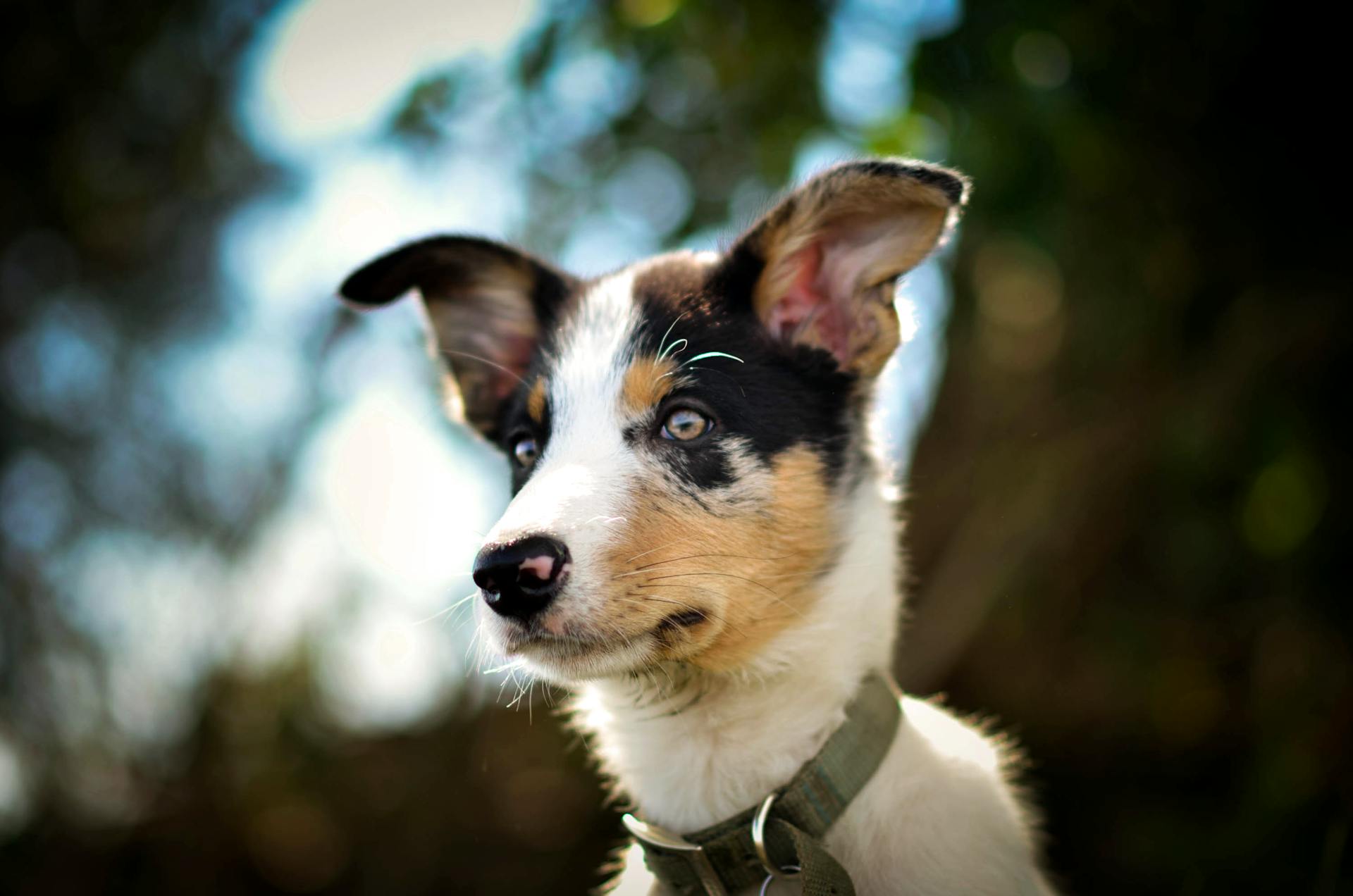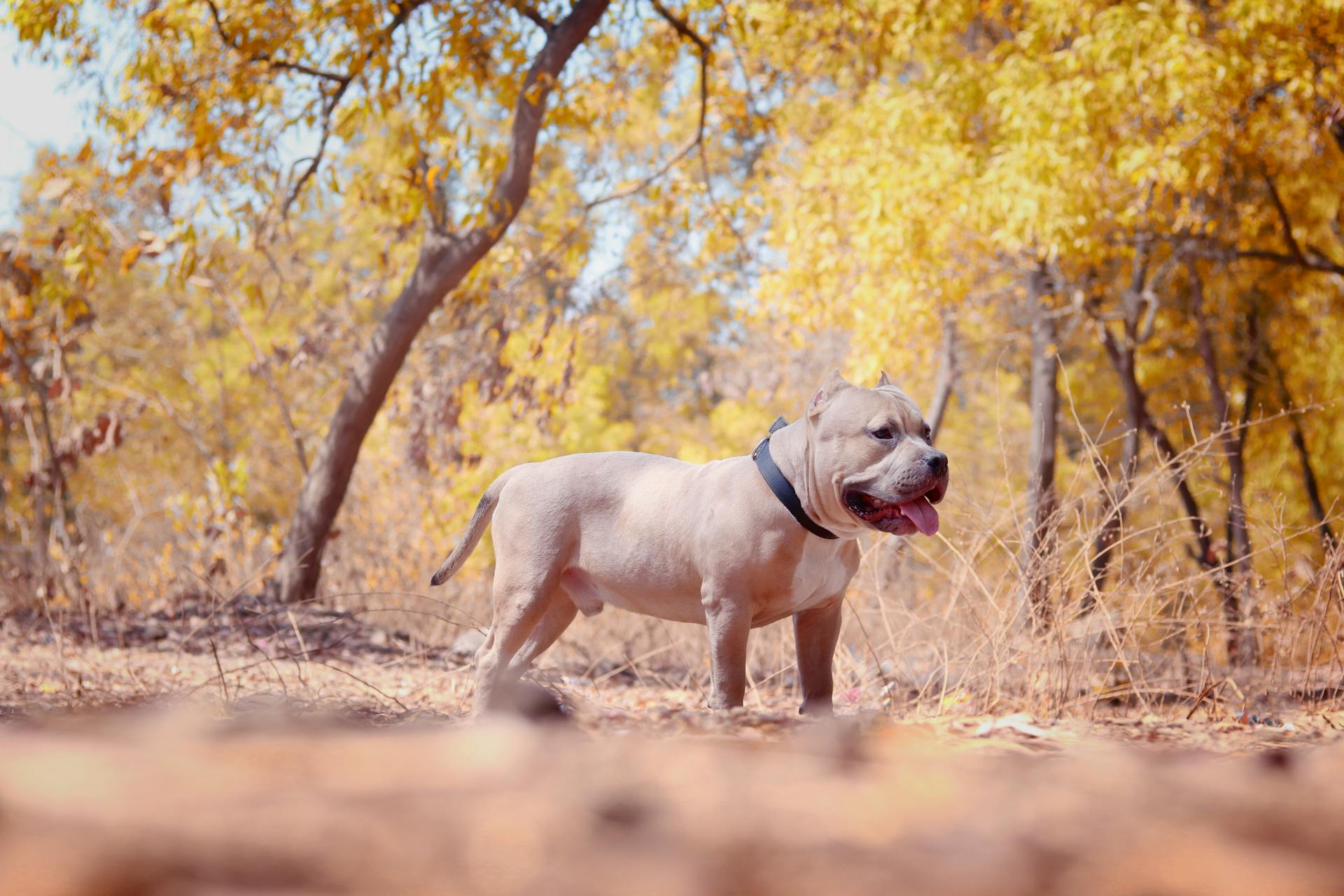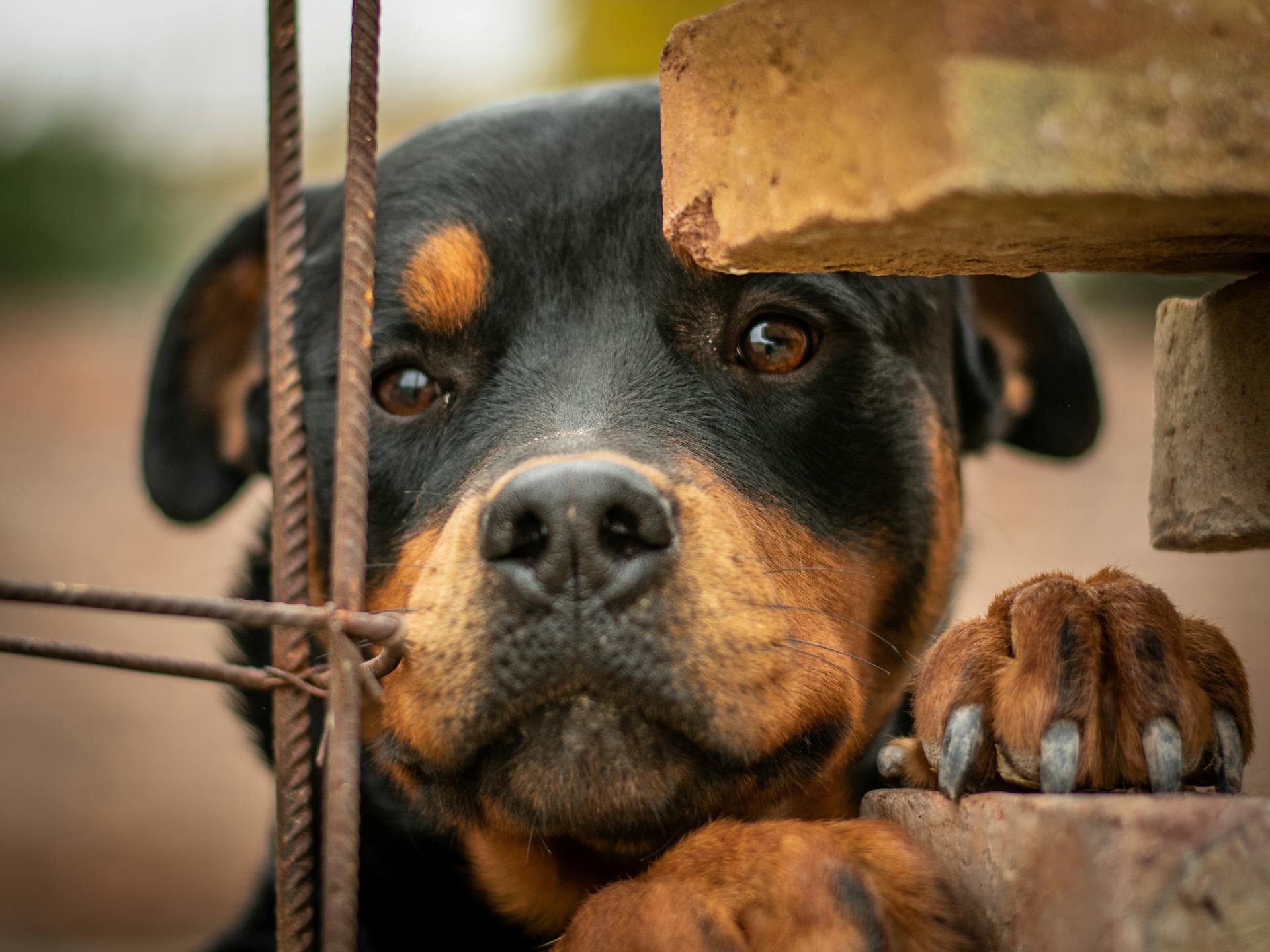
The American Bully Merle is a unique and captivating breed that has gained popularity worldwide.
One thing to note about the American Bully Merle is its genetic makeup, specifically the merle gene mutation that gives it distinctive coat patterns.
This mutation can come with some health risks, including deafness and vision problems in both parents and offspring.
For your interest: Merle Bull Terrier
American Bully Merle Health
Unfortunately, there are health problems associated with the merle gene mutation that you should know about if you're considering getting an American Bully puppy.
The merle coat pattern is popular because it's unusual and unique, but it can lead to eye or ear deformities in double merles, which are dogs that have two copies of the merle gene. This can result in complete blindness and deafness.
It's essential to understand that breeding two merle-coated American Bullies together increases the risk of producing a disabled puppy, so it's crucial to do your research before bringing home a new furry friend.
Gene Mutation Health Risks
The merle gene mutation can cause significant health problems in dogs. Unfortunately, this is especially true when two merle-coated dogs are bred together.
Double merles, which occur when both parents have the merle gene, are highly likely to suffer from eye or ear deformities, and at worst, complete blindness and deafness. This is a serious concern that has led some organizations, like the Kennel Club in the UK, to ban breeding double merles altogether.
The health risks associated with the merle mutation can be devastating for dogs and their owners. It's essential to understand these risks before deciding to breed or purchase a dog with this coat pattern.
Detailed Summary
The American Bully Merle coat color is determined by a genetic test that checks for the M (merle insertion variant) Allele of the PMEL gene.
This test can also determine the approximate size of the M allele(s), which has been associated with different merle coat colors and patterns. The size of the M allele(s) present in a dog can impact the expression of the PMEL gene, affecting eumelanin (black pigment) areas but not phaeomelanin (yellow/red) pigmented areas.
For your interest: Yorkshire Terrier Coat Type
The Merle gene is inherited in a dominant fashion, meaning that only one copy of an M allele is necessary for a dog to display some variation of the merle coat color or pattern. This can result in random dilution of eumelanin leaving patches of normal coat color within areas of diluted pigmentation.
Two copies of the large M allele are thought to cause significant white areas of the coat, eye abnormalities, and deafness due to the death of skin melanocytes, retinal pigment cells, and melanocytes of the inner ear. This is a serious health concern for American Bully Merle dogs.
Expand your knowledge: American Bully Tri Color
Breed Standards and Testing
The American Bully Merle breed has a unique genetic makeup that affects its appearance and characteristics.
To ensure consistency with breed standards, responsible breeders test their dogs for certain genetic traits, including merle pattern genetics.
This testing helps identify potential health risks associated with the merle gene in American Bully Merles, such as deafness or vision impairment.
Standard
The standard for a breed is set by its governing body, such as the American Kennel Club (AKC) or The Kennel Club (KC).
In most cases, these standards are based on specific physical and behavioral characteristics that have been established over time through careful consideration of the breed's history, purpose, and typical traits.
The AKC, for example, has a detailed description of the ideal Poodle, including its size, coat type, and temperament.
Breed standards typically include information about the dog's body structure, such as its height, weight, and skeletal proportions.
In addition to physical characteristics, breed standards often address the dog's behavior, including its level of energy, trainability, and potential for herding or guarding instincts.
You might like: Bull Terrier Dog Breed
Testing Summary
The M Locus (Merle) coat color test is a reliable way to determine if a dog carries the M allele of the PMEL gene.
This test will also give you an approximate size of the M allele(s), which can help you understand the potential merle coat colors and patterns your dog may display.
On a similar theme: Smooth Haired Fox Terrier Puppies
Merle is inherited in a dominant fashion, meaning that only one copy of an M allele is necessary for a dog to show some variation of the merle coat color/pattern.
The M allele impacts canine coat color by altering the expression of the PMEL gene, which affects eumelanin (black pigment) but not phaeomelanin (yellow/red) pigmented areas.
Dogs with two copies of the M allele large enough to produce the merle coat color may also experience significant white areas of the coat, eye abnormalities, and deafness.
Care and Veterinary Advice
American Bully care tips are essential for a happy and healthy life. American Bullies have short coats that are fairly low-maintenance.
Regular grooming is necessary to keep them clean and healthy. Schedule regular veterinary check-ups to ensure your American Bully remains healthy.
Tom Novo, an enthusiastic owner of an eight-year-old American Bully named Rocky, recommends keeping up with vaccinations, parasite control, and other recommended healthcare measures.
Veterinary care should be a priority for any responsible dog owner. Regular veterinary check-ups will help navigate the roadmap to optimal dog health.
Intriguing read: American Bully Care
Temperament and Behavior
The American Bully Merle is known for its gentle and friendly temperament.
They have an affectionate nature and make loyal companions, often showing great affection towards their family members. This makes them a great choice for families with children.
Proper socialization from an early age is essential to ensure that they are well-adjusted and friendly around other animals and unfamiliar individuals. With the right training and socialization, American Bullies can become well-mannered, friendly, and well-adjusted companions.
Bully Temperament
The American Bully temperament is truly something special. They're known for being gentle and friendly, making them a joy to be around.
One of the standout characteristics of American Bullies is their affectionate nature - they love to show love and attention to their family members! This makes them great companions and loyal friends.
As social animals, American Bullies are naturally good with children and can thrive in families. However, proper socialization from an early age is crucial to ensure they're well-adjusted and friendly around other animals and unfamiliar individuals.
These dogs are also highly intelligent and eager to please, which makes them a breeze to train - especially when using reward-based methods like treats, praise, and play as incentives! They respond well to positive reinforcement and consistent training.
Teaching basic obedience commands is vital for American Bullies, and with patience and practice, they can learn to be well-mannered and friendly adults.
Final Thoughts
American Bully bloodlines have unique characteristics that are worth considering when looking for a new pet.
The rise in popularity of Bully breeds means there are more potential forever homes available, but it's essential to find a reputable breeder who prioritizes their dogs' health and uses ethical methods.
To ensure your American Bully lives a long and happy life, make sure the breeder you choose follows responsible breeding practices.
Related reading: Staffordshire Bull Terrier Kennels
American Bully Merle Controversies
Breeding two American Bully merles together is a high-risk endeavor that can lead to disabled puppies.
Not everyone knows the risks associated with breeding merle to merle, which means many accidental double merle creations will continue to occur.
Ideally, anyone selling an American Bully merle puppy should explain the risks to the new owner, but this often doesn't happen.
Additional reading: Bull Terrier Bred for
Frequently Asked Questions
How much is a merle American Bully?
Merle American Bullies typically fall within the same price range as other American Bullies, costing between $1000-$5000 or more, depending on factors like age, health, and temperament
What is a merle American Bully?
A merle American Bully is a dog with a distinctive swirly-twirly coat pattern resulting from a specific gene. However, this attractive appearance comes with significant health implications that owners should be aware of.
Are merle dogs good or bad?
Merle dogs are not inherently 'good' or 'bad', but they may be prone to certain health issues, including hearing loss. Learn more about the potential risks and benefits of owning a merle dog
Why is merle not accepted?
Merle is not accepted due to its association with a higher risk of eye and ear problems in dogs. This increased risk can lead to blindness and/or deafness in affected puppies.
How rare is a blue merle pitbull?
A blue merle Pitbull is extremely rare due to the genetic issue associated with the merle gene. This rarity makes them highly sought after by enthusiasts.
Sources
- https://medium.com/bully-king-magazine/the-merle-coat-acceptable-in-the-american-bully-breed-7c7164270b2b
- https://www.dogster.com/dog-breeds/american-bully-bloodlines
- https://dogsbestlife.com/dog-breeds/american-bully-health-issues/
- https://nationalkennelclub.com/american-bully/
- https://www.pawprintgenetics.com/products/tests/details/171/
Featured Images: pexels.com


